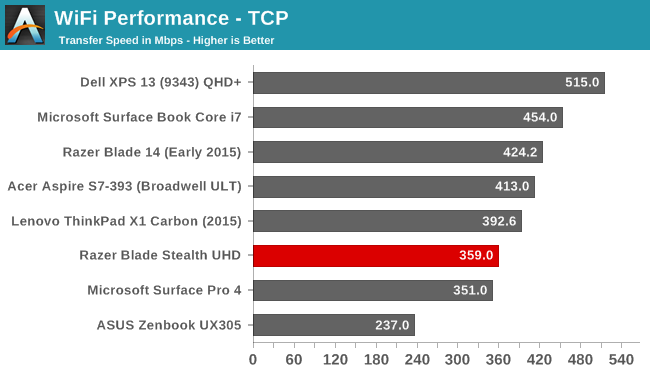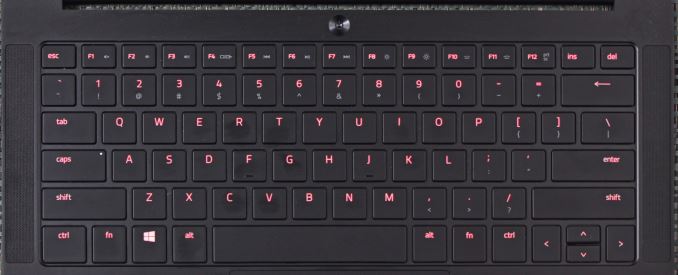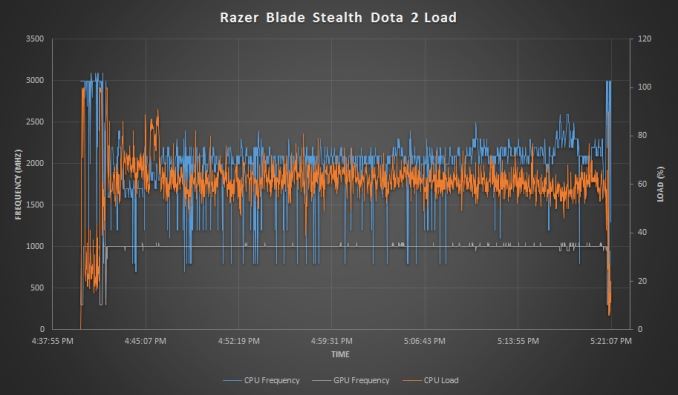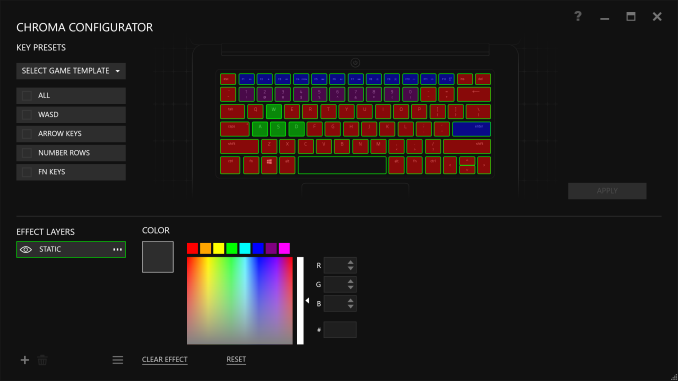The Razer Blade Stealth Review: Razer Takes On The Ultrabook
by Brett Howse on March 29, 2016 8:00 AM EST- Posted in
- Laptops
- Razer
- Skylake
- Razer Blade Stealth
- eGFX
- Razer Core
- Skylake-U
Wireless
For a wireless solution, Razer has moved to the Killer Wireless 1535, which is a 2x2:2 solution with support for 802.11ac. This gives a maximum connection speed of 866 Mbps, and of course real-life results will be less than that. Killer bundles software which the company has designed to help with gaming – once again going back to Razer’s gaming roots. The software is basically fancy QoS for your laptop, prioritizing gaming traffic to prevent simultaneous network usage from diminishing the latency for any gaming sessions.
Out of the box, the Stealth is pretty far from a gaming notebook, but of course once you pair it with the Razer Core external graphics, this use of a gaming solution makes more sense. Killer has changed their business model quite a bit over the years, from expensive stand-alone network cards, to integrated solutions with some software features on top. I’ve had good experiences with the Killer network cards on other gaming laptops in the past, and the Stealth is no exception. Connections were always fast and stable. Since I’m no where near Josh, I won’t be able to use the Ixia WaveDevice to test Wi-Fi performance, which is kind of a pity. Instead we’ll have to stick with the normal copy speed performance test.

The Razer Blade Stealth averaged 359 Mbps on our standard SMB file copy test, which is not the best result we’ve seen from a Killer 1535. MSI’s GT80 Titan got over 100 Mbps higher on this test with that card. Comparing to other Ultrabooks, it is far from the top result we’ve seen.
Speakers
Very few Ultrabooks manage to squeeze the speakers onto the top of the notebook. The majority point them down, and then there are ones like the XPS 13 which put them on the side. Microsoft has put the speakers right on the side of the display bezel on the Surface Book, which provides good stereo separation. Razer has also made room for the speakers on the top of the laptop. In this case, they are flanking the keyboard itself.
The result is great stereo separation, and the sound quality of the speakers is good for an Ultrabook. With the limited space available, there’s just no way to fit in speakers large enough to really cover the entire audio range, but the Stealth sounds as good as any Ultrabook out there. The volume is also very good, with just a hair over 83 dB(A) measured with the SPL meter an inch over the trackpad.
Thermals and Noise
Coming from a background in gaming notebooks, Razer should know a thing or two about system cooling. When designing a thin and light laptop, cooling can often be a soft spot. Despite the low thermal output of the U series processors, the heat still needs to go somewhere.
At idle, the notebook is basically inaudible, with my sound meter bottoming out at 36 dB(A) which is pretty much the noise floor of my office. You can barely hear the fan, which seems to run all the time but at a speed that you can’t really notice it. Some notebooks have the fan off as much as they can, but then the fan tends to ramp up and down when needed to keep the temperatures in check. With it on all the time, the need to ramp up is reduced.
Once you work the device, it does get louder, but never excessively so. After about 45 minutes of gaming, the Stealth game in at 46 dB(A) as the maximum fan speed that was audible, but most of the gaming session was closer to 41 or 42 dB(A), which is very quite for an Ultrabook in that situation.
With the fan running so quietly, there is likely concern that the chip itself is throttling. Over the same gaming session, the CPU frequency, GPU frequency, and CPU load was logged, as well as the SoC power. The SoC was limited to 15-Watts power, which is correct, and never reduced over the session.
When an Ultrabook SoC throttles under gaming load, the GPU frequency will drop by 100, 200, or more MHz. The Stealth is able to maintain the 1.05 GHz frequency for the entire session. The CPU frequency does drop, but that’s normal on a gaming workload since the SoC transfers more of its power budget to the GPU.
The noise is never excessive, and the device doesn’t throttle. That is a great result for the Stealth. The device itself, being made out of aluminum, does get warm to the touch, especially at the hinge. Since the cooling system vents out the back of the laptop in the gap between the display and the chassis, the warm air is concentrated there and I measured 46°C right at that spot. Luckily the rest of the notebook was no where near that warm, coming in around 35°C. Warm, but not hot.
Software
Razer includes their Synapse software, as well as their Comms software. Other than that, the only other software installed is Dolby Digital audio manager, and Killer software for the network card. This is as close to a signature PC as you’re going to get from any OEM, and that’s a big compliment.
The Synapse software is the heart and soul of Razer’s products. You can just it to customize lighting for the keyboard and any Razer mouse, set up Macros, and more. Razer has stats and heatmaps for key usage during gaming sessions, and of course the Chroma Configurator.
Using the Chroma Configurator, you can basically map out any color to any key at any time. You can set up profiles for games, or set every single key to a different color if you want. They have basic settings for the number row, WASD, arrow keys, and function keys, but you can also select any, or any multiple of keys to program to whatever you want. It’s very simple and extremely powerful, and having certain keys a different color can make it easier to map out what key is what. For instance, something I use a lot is Print Screen. Since that function key is different on every laptop, I can set F12 (the key with Print Screen as a secondary function) to red so I can see it anytime. I can set the volume keys to blue. It’s very powerful and functional, and of course it lets you personalize the system to just how you want it. Razer has traditionally offered Razer Green as their backlighting color, but with full Chroma, the Stealth offers anything you want.
Chroma Apps is an SDK which software developers can leverage to put custom lighting patterns on the keyboard when you use their app. A game, for instance, can set up a color scheme for you.
The other installed bit of software is Razer Comms. This is something I’ve not used (who has time for online gaming anymore?) but it’s a lightweight chat client for use when gaming. It provides an overlay over the game so you can manage chat sessions without having to switch out of the game. It’s free for anyone, so you don’t have to just talk to other people with Razer laptops.














66 Comments
View All Comments
forgot2yield28 - Thursday, March 31, 2016 - link
Won't benefit the end user? Are you kidding? If you do any kind of work viewing fine vector images, such as architectural displays, a high DPI display is a godsend. For productivity software, if you have good eyesight and don't mind shrunken UI elements, you fit your work on more of the screen. It's obviously a tradeoff against battery life, but it's a tradeoff some would gladly make. It's simply not true to state there are zero use cases where a high DPI display provides a tangible benefit.niva - Friday, April 1, 2016 - link
You can disagree all you want, but anything below 1080p should be immediately disqualified from being purchased 5 years ago. An argument about 1080p for the sake of efficiency can be made, but discouraging companies from adopting higher resolution standards is just wrong. The UHD display can be ran as a 1080 for performance purposes.moozooh - Saturday, April 2, 2016 - link
> An Intel GPU in a 12.5 inch laptop display that is unable to drive games at much lower resolutions should be paired with a 1366x768 panel of decent quality with good viewing angles.That is just silly. Gaming performance is never a goal with laptops of this form-factor, not even a secondary one. If you're looking for any kind of decent gaming performance you shouldn't be considering an Ultrabook at all. Their primary task is the ability to handle large amounts of text, non-computanionally-intensive media work, and internet browsing/media consumption on-the-go for as long as possible without having to be plugged in. The difference between a 120 dpi panel and a 190+ dpi panel when working with text or photos is MASSIVE. They aren't even comparable, not if you value your eyesight and comfort at all. Had you experienced that you would never write the nonsense about 768p panels.
deeps6x - Wednesday, April 6, 2016 - link
Which is why they should have had a 1080P option with a nice Matte IPS screen. 13.3", not the micro size they went with. It fits. Use it Razor. You build this fine ass machine then gimp it with the large bezels. If Dell can do it you can do it as well, if not better.Why 1080P? Because it uses less power than 3k or 4k, and extends battery life. Why matte screen? Because touch is Intel forced cow poop, and I like to be able to use my laptops with windows behind me. Or even outside. I don't know what kind of profit Intel makes by insisting touch screens are part of the 'Ultrabook' spec, but it is one of their dumbest ideas ever. Touch on a tablet? Of course. Touch on a laptop? Useless.
jlabelle - Thursday, April 28, 2016 - link
- Higher resolution displays, while nice looking, offer little to no added functionality after reaching the point -So...it does !
And let's be honest, we are still far from smartphone resolution. I am not pushing for 4K display on a 12" screen but there is a CLEAR difference between 768p and QHD on such size.
- after reaching the point where it becomes necessary to scale the interface in order to retain visibility of objects displayed in it -
Which is not a issue per see. Windows Store applications and UI just scaled perfectly. It is old legacy software that needs to be adapted for that so indeed, it is a good thing to evolve in this direction to force the software manufacturer to make their homework as high DPI support exists on Windows since more than 7 years.
- Anything more than that won't benefit the end user regardless of how much they think they need more pixels.-
It does. What does NOT is the aRGB screen, which, as explained, for most of the operation is detrimental to the user experience.
mikesackett.85 - Thursday, March 31, 2016 - link
768 is awful, 1080p should be the minimum. Having been spoiled by nice high DPI screens (1600-1700p) I'll never go back to anything less than FHD. For me the QHD model hits the sweet spot at $999.99, for that you get an i7, 8GB Ram, 128GB SSD, and QHD touchscreen, which is higher specs than the similarly priced XPS 13 (i5, 1080p, 8GB RAM, 128GB SSD, non-touch) and a similar specced MBP is $1299. This laptop also has the added bonus of having a thunderbolt connected dGPU which none of the other options have (Though the Razer dock should work on other pc's with thunderbolt ports, including the Dell XPS 13). This laptop has the ability to serve both as a road warrior and in-home gaming machine, for that I feel it is absolutely worth the price of admission.Kristian Vättö - Tuesday, March 29, 2016 - link
I agree. The battery life is a big drawback considering that the competitors offer nearly twice the battery life.A part of my wonders why won't Razer offer a model for the normal consumer. Kill the fancy keyboard backlight and offer i3 and i5 CPUs, and the Stealth could be very competitive against the likes of Dell and ASUS. I know Razer is all about gamers, but the Stealth looks like a very solid machine and given Razer's higher-end brand status and quality I'm sure they could reach a wider audience with just a few small tweaks.
zeroqw - Tuesday, March 29, 2016 - link
Exactly. I have been monitoring the ultrabook market for 2 years and to be honest this laptop could have been a big hit with real battery life. It feels like all the ultrabook laptops got some smaller or bigger drawbacks and you just cant get what you pay for. I just hope they consider moving closer to a wider audience in the future.nerd1 - Tuesday, March 29, 2016 - link
They can provide FHD (matte) screen with i5 version at $799, which should last twice longer than this.ImSpartacus - Tuesday, March 29, 2016 - link
Since at first glance, it appears that Razer is emulating parts of Apple's strategy, I would guess that Razer is ensuring that every modern system in the Razer "ecosystem" can have a satisfactory experience with their Core.The Blade 14 & 17 are both easily up for the task. And Razer at least attempted to ensure that every Stealth will be a good match for the Core. However, if they put a weaker 15W CPU in there, then it might not perform as well with the Core.
Is that the right thing to do? Objectively no, but I wonder if that kinda of Apple-esque way of thinking of part of the reason why the Blade laptops seem to be so cool in the first place. You take the good with the bad, I guess.